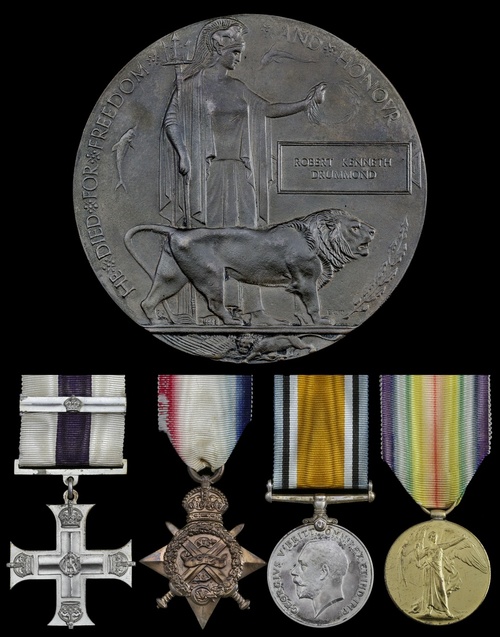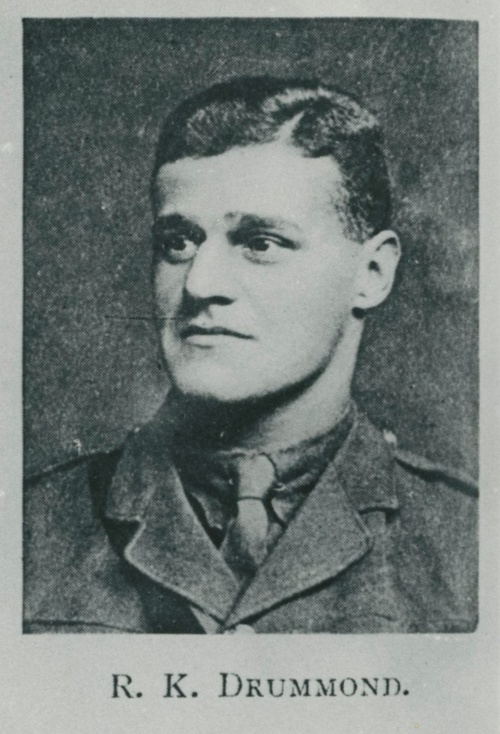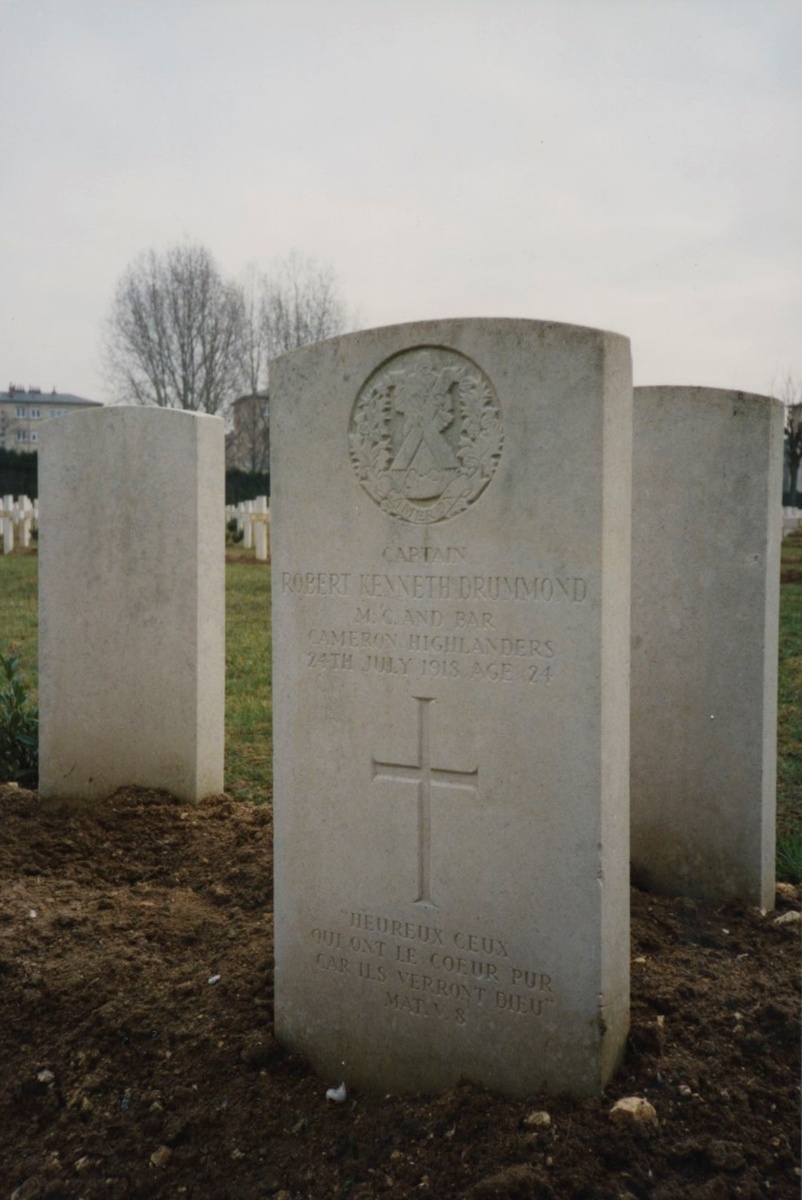Auction: 19002 - Orders, Decorations and Medals
Lot: 375
'Captain Robert K. Drummond, whose death is widely mourned both in Edinburgh and Glasgow, was a fine example of the chivalry and daring which have characterised the representatives of the Manse in this great struggle for righteousness and truth. One does not always associate the sweeter influences of Manse life with militancy of any kind, yet it is a fact that the Manse has played as noble a part in all that concerns the war as any class in Scotland. And the sad thing is that many with radiant visions of a fuller life have made the great sacrifice. Captain Drummond is one.'
Drummond's obituary in The Scots Pictorial 31 August 1918, refers.
The poignant M.C. and Bar group of five awarded to Captain R. K. Drummond, 6th Battalion, Cameron Highlanders, who showed outstanding leadership under heavy fire during the Switch Line Offensive on 12 August 1916
While leading a bombing attack at Le Trasnoy three months later, Drummond selflessly carried a wounded man into a shell hole, saving his life at great risk to his own. When his men ran out of ammunition, he carefully extricated them from a perilous situation, receiving a Bar to his M.C.
Tragically, Drummond was mortally wounded during an ill-conceived assault on Soissons on 23 July 1918. The terrain slowed the Allied advance, and the Camerons came under heavy fire in the Crise Valley, Drummond giving his life to bring his men to safety
Military Cross, G.V.R., with second award Bar; 1914 Star (2208 Pte R. Drummond. 9/High. L.I.); British War and Victory Medals (Capt. R. K. Drummond.); Great War Bronze Memorial Plaque (Robert Kenneth Drummond), in card case of issue, very fine (5)
M.C. London Gazette 26 September 1916:
'For conspicuous gallantry during operations. When the company commander was wounded he took command, and, discovering that his men had advanced too far, reorganised them and brought them back under heavy fire of all kinds. His fine example and prompt action kept his men steady.'
Second Award Bar to M.C. London Gazette 14 November 1916:
'For conspicuous gallantry when leading a bombing attack. He showed great determination, and when a withdrawal became necessary owing to lack of bombs, he helped to get a wounded man into a shell-hole, whence he was rescued after dark. He was under continuous fire all the time.'
Robert Kenneth Drummond was born at 3 East Castle Road, Edinburgh in 1894, the elder son of the Reverend Robert James Drummond, D.D., Edinburgh, Moderator of the General Assembly of the United Free Church and Chaplain to the King. Of Manse descent, he attended George Watson's College and played rugby both for the 'Watsonians' and the West of Scotland. He studied at Edinburgh University, and became an articled clerk in the office of Messrs. McClelland, Kerr & Co., chartered accountants in Glasgow.
Drummond enlisted into the 9th Battalion, Highland Light Infantry (Glasgow Highlanders) in August 1914 and the Battalion entrained for Southampton on 2 November, with a strength of 30 officers and 1,008 other ranks. It reached Le Havre via S.S. Novia on 5 November, and marched into billets at Wardrecques. Part of 5th Brigade, 2nd Division, it moved into the firing line at Kemmel on 25 November. The Regimental War Diary records that the trench was too shallow, as the bottom was stuffed with French dead. Drummond was seriously wounded at Richebourg on 15 May 1915, during a failed night attack intended to capture Ferme du Bois, a strategic objective in the Battle of Festubert. Invalided home, he recovered and was granted a commission in the 6th Battalion, Cameron Highlanders, returning to France in May 1916.
The 6th Camerons took part in the Switch Line Offensive on 12 August that year, as part of Brigadier-General Allgood's 45th Brigade. The Camerons occupied and consolidated the all-important Munster Valley section of the Switch Line, holding it despite a fierce German bombardment. Drummond took command of his company after its commander had been wounded. Realising that his men had advanced too far, he brought them back under heavy fire, showing a fine example to his men. His gallantry on this occasion earned him the Military Cross. His Bar was conferred for the Battle of Le Transloy on 18 October, when Drummond led a bombing attack with great bravery and initiative. After running out of ammunition, he extricated his men and helped a wounded soldier into a shell-hole, from whence he was later rescued. Promoted to Lieutenant, Drummond was given six months' home service. He returned to his Battalion in April 1917, during the Battle of Arras.
Just prior to the Allied Hundred Days' Offensive, the 6th Camerons were involved in a move against the German-held town of Soissons on 23 July 1918. Part of the 45th Brigade under Brigadier-General N. A. Orr-Ewing, the Battalion advanced over ground dissected by the valleys of the Crise stream and its tributaries. Moving down the Crise's steep bank, the Camerons struggled to make progress and were subjected to frontal fire at short range. German artillery meanwhile enfiladed their left flank.
The Camerons succeeded in capturing a sugar factory at the bottom of the Crise valley, but this only left them more exposed. A German counter-attack at 6 p.m. was beaten off with heavy loss. Seeing that his men had advanced too far, Drummond reorganised them and evacuated the factory that night. Drummond brought his men to safety, but was mortally wounded during the withdrawal. He died the following day, aged 24, and is buried in the Royallieu French National Cemetery, Compiegne, Picardy. His French epitaph, doubtless chosen by his father, reads: 'Blessed are those whose hearts are pure, for they will see God' (Matthew, 5.8). He is commemorated on the family headstone at Grange Cemetery, Edinburgh.
Sold with a photograph of Drummond's grave, and a Commonwealth War Graves Certificate.
Subject to 20% VAT on Buyer’s Premium. For more information please view Terms and Conditions for Buyers.
Sold for
£3,500
Starting price
£2200









